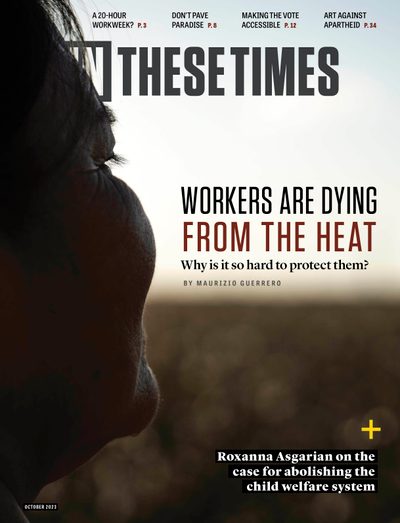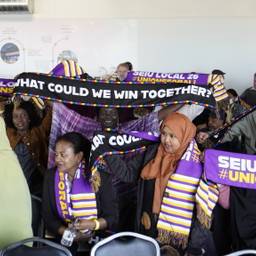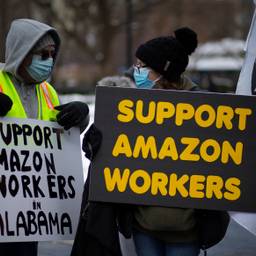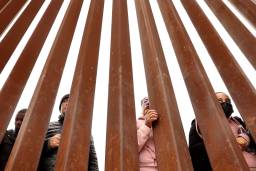Workers Are Dying From the Heat: Why Is It so Hard to Protect Them?
No federal heat standard exists and lobbyists, corporate interests and those with fiercely anti-regulatory agendas have been vocal and active in keeping it that way.
Maurizio Guerrero
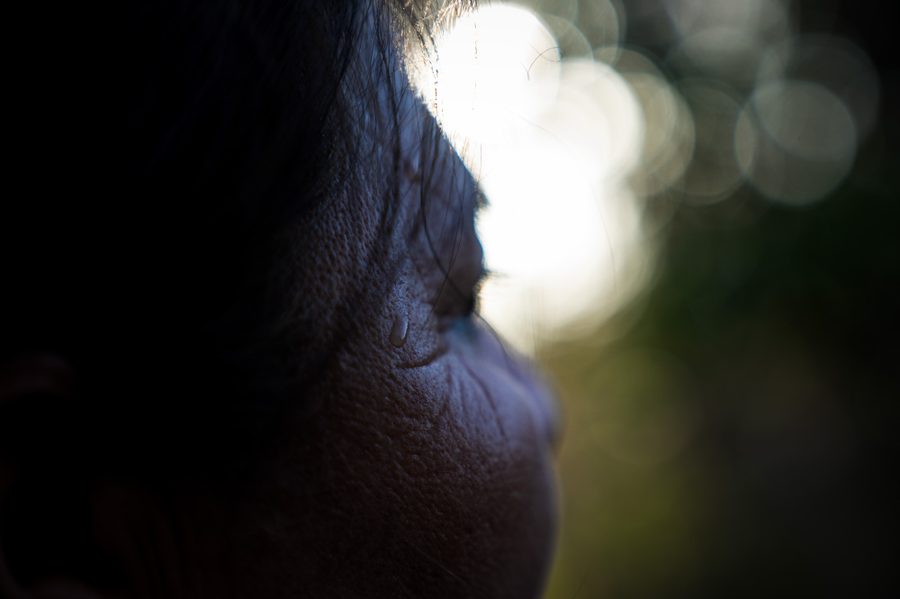
Lea este artículo en Español.
As temperatures soared past 100 degrees in early August in the fields of the Rio Grande Valley, near the U.S. – Mexico border, María Pérez, a 53-year-old farmworker who emigrated from the Mexican state of Michoacán eight years ago, felt faint. In the field, she was removing plastic mulch used to ripen watermelons. She vomited after drinking the only available water, which was already lukewarm. (Pérez requested we use a pseudonym for fear of retaliation.)
The heat made Pérez’s jaw clench and heart race. Day after day, she says, those sensations persisted. Water only continued to make her “feel like vomiting,” she adds in Spanish. A mother of three, Pérez often works eight-hour shifts in the fields without access to shade, even during her 15-minute lunch breaks.
Pérez says that one day when she felt nauseated, she nervously approached her supervisor and asked to leave. According to Pérez, she was offered only this small consolation: “You can work a little slower.”
Despite these brutal conditions, Pérez says she doesn’t have many options.
Twenty-one of the past 22 years have been the hottest on record in the United States. Workers are dying of heat exhaustion in service of some of the wealthiest corporations on the planet (the majority working in agriculture and construction). Heat-related death and injury reports have been routine across the country, but nothing has firmly swung the pendulum toward sufficient heat standards nationwide.
At face value, policies to protect workers against the heat seem like an obvious necessity. Workers laboring under scorching temperatures often pass out and collectively experience more than 100,000 heat-related injuries each year. They need basic protections to stay healthy and, well, keep working. For example, California’s Heat Illness Prevention Standard mandates that employers provide outdoor workers with access to shade, water, and heat safety training. These types of policies are a seemingly easy win for capitalism and its sustained exploitation of cheap labor.
But no federal heat standard exists, though it was recommended more than 50 years ago by the National Institute for Occupational Safety and Health, part of the Centers for Disease Control and Prevention. The nonprofit consumer advocacy group Public Citizen petitioned for a heat standard in 2011, as well as in 2018 and 2021 — when more than 130 organizations signed on as endorsers — but, still, no such federal standard exists.
What underpins the debate around heat standards are short-term profit mentalities — unconcerned with human costs — coupled with a free-market ideology that says businesses should be unburdened by most regulations. Lobbyists, corporate interests and politicians with fiercely anti-regulatory agendas have been vocal and active in blocking new heat standards while also frequently trying to undo or defy local heat regulations.
Prioritizing profits over workers’ lives and health by challenging even commonsense protections has caused “violent deaths that are entirely preventable,” says Elizabeth Strater, director of strategic campaigns for United Farm Workers, a labor union founded in the early 1960s by activists Dolores Huerta, César Chávez and others. “That is why it is so enraging that we continue to have employers perfectly willing to kill their workers because it’s a more profitable business model.”
The Occupational Safety and Health Administration (OSHA) is developing a new rulemaking process for heat standards — an effort that began around two years ago — but standards at the agency historically take an average of seven to eight years to complete, according to the U.S. Government Accountability Office (GAO), the nonpartisan congressional watchdog. Some take as long as two decades to implement. According to a GAO report titled “Workplace Safety and Health: Data and Enforcement Challenges Limit OSHA’s Ability to Protect Workers during a Crisis,” published in 2022, the slowness is in part because of “increased procedural requirements, shifting priorities” and a rigorous judicial review.
Meanwhile, efforts to block heat protections for workers are expanding nationwide as advocates organize to enact them to stem the disturbing regularity with which workers are getting injured or dying.

Where Even the Heat’s Bigger
Texas workers have no specific state-mandated heat protections — no water breaks, no mandated access to shade, no heat-illness prevention measures for workers (or their supervisors) and no temperature threshold that requires outdoor work to cease. The state registered 42 work-related heat deaths between 2011 and 2021 — more than any other state, according to the Bureau of Labor Statistics. The situation is made increasingly dire by the recent proliferation of wildfires, which multiply the dangers of heat; breathing smoke during extreme temperatures increases a worker’s chance of dying from heat stress.
After deadly heat waves in 2010, the Workers Defense Project, a Texas-based worker center — where U.S. Rep. Greg Casar (D-Texas) was advocacy director at the time — helped successfully fight for city ordinances in Dallas and Austin requiring employers to provide construction workers with a 10-minute water break every four hours. But the Republican-led state legislature attempted to override even that meager mandate in April, approving instead what critics call the “Death Star” law, known in Spanish as “la ley que mata,” the “law that kills.” HB 2127 would, among other things, preempt any local ordinances mandating rest and water breaks for construction workers and would help prevent such laws from being enacted in the future.
Recently, Texas has largely been a success story for business lobbyists and far-right interests striving to roll back or block heat protections for workers. The National Federation of Independent Business (NFIB), an influential lobbying organization, self-described as the “voice of small business,” has played a major role. While NFIB is a nonprofit, and not required to disclose its donors, one of the wealthiest families in the United States, the Kochs, has reportedly backed NFIB in the past.
HB 2127 and companion legislation was introduced to the Texas legislature by state Sen. Brandon Creighton and Rep. Dustin Burrows, and “will make the cost of business even lower, the ease of business even better,” according to Texas Gov. Greg Abbott, who signed the bill in June. But just days before the law was scheduled to go into effect, a district court judge ruled the bill unconstitutional. The state is expected to appeal.
“The judgment today by a Democrat Travis County District Judge is not worth the paper it’s printed on,” Burrows blasted on Twitter. “The Texas Supreme Court will ultimately rule this law to be completely valid. The ruling today has no legal effect or precedent, and should deter no Texan from availing themselves of their rights when HB 2127 becomes law on September 1, 2023.” An analysis by Burrows claims that, by eliminating any such heat protections, “job creators” will be allowed to “focus their resources on growing their businesses.” In the same Twitter post, Burrows contemplated how the legal situation would have played out if there were business courts. “As an aside, given what happened today in the Travis County District Court,” he wrote, “I now better understand why the business community was clamoring for the creation of specialized business courts to ensure our state’s laws are fairly upheld and our justice system is preserved.”
Worker advocates contend that the law would serve to dismantle progressive ordinances that improve worker and tenant protections. They describe it as a bold attempt to kneecap municipal democracy in Texas, especially in cities with more liberal reputations.
The Texas AFL-CIO, a state federation of labor unions, called the ruling “a HUGE win for the working people of Texas, local [governments], and communities across our state. While we expect an appeal, it remains clear this law is an unacceptable infringement on the rights of Texans and cities.”
NFIB’s fingerprints were visible on HB 2127. When Creighton and Burrows announced it, their press release even included a statement from Annie Spilman, NFIB’s state director, stating that the “patchwork of regulations” in Texas “makes it more difficult to own and operate a business.” It was one of the only national business groups supporting the bill, though it was joined by some Texas associations, including the state chapter of the Associated Builders and Contractors, which has played a role in debilitating unions for more than five decades and lobbied against improvements in workplace standards and jobsite safety. Creighton also thanked the NFIB, the only business group he singled out, which “worked for years to make this bill possible.”
Advocates and some politicians, like Casar, are pressing Congress and the Biden administration to approve heat standards as a matter of labor, social and racial justice. Heat illnesses and injuries disproportionately affect people of color and immigrants, primarily poor Black and brown people and undocumented workers from Latin America.
“Bought-and-paid-for politicians like Gov. Abbott are stripping workers of their right to a water break in the middle of a historic heat wave,” Casar said in a statement in July, issued with a letter to the U.S. Department of Labor. More than 100 Democratic federal legislators signed the call for a federal heat standard.
The letter reads, in part, “This year has already brought record high temperatures that have led to preventable deaths in the workplace. In Dallas, Texas, a USPS employee … died while on his route in 115-degree heat. In Harrison County, Texas, a 35-year-old lineman working to restore power died, likely from heat exhaustion. We know extreme weather events such as heat waves are becoming more frequent and more dangerous due to climate change. Urgent action is needed to prevent more deaths.”
In response to questions about the situation for workers in Texas, press assistant Haley Crow emailed a statement to In These Times, which she attributed to Andrew Mahaleris, a spokesperson from Governor Abbott’s office. “Nothing in Texas or federal law prohibits employers from allowing workers to take water breaks in hot weather. [Bill 2127] maintains the federal Occupational Safety and Health Administration’s (OSHA) standards to keep workers safe and will not inhibit people from taking water breaks.” The email also asserted that “Austin and Dallas are the only two cities in Texas that ever had such regulation.”
A day after releasing the letter, Casar staged a vigil and thirst strike on the steps of the U.S. Capitol, seeking to pressure the Biden administration to pass federal heat protection standards.
“The corporate lobby against basic water breaks has been very successful for years. They have kept OSHA from passing any kind of federal rule,” Casar tells In These Times. “The only way to beat that kind of organized money is through organized people.”
NFIB has been blunt in its opposition to a federal heat standard. In a public comment on the proposed OSHA rule, NFIB urged OSHA to accommodate “the needs of America’s small businesses and the American economy.” The statement was signed by David S. Addington, NFIB’s senior vice president, general counsel, and chief legal officer, who was also vice president for research at the conservative Heritage Foundation and chief of staff and legal counsel to former Vice President Dick Cheney.
Addington stressed that “OSHA should proceed no further with the heat rulemaking process.”
The Untold Heat-Related Deaths
July 2022 was the hottest July in the history of Galveston, Texas, with temperatures exceeding 90 degrees. This August, temperatures in that touristic coastal city in southeast Texas regularly rose over 100 degrees. Amid both heat waves, Isabel Ramírez, a 52-year-old construction worker who emigrated from El Salvador more than three decades ago, worked regular 10-hour shifts. As part of a demolition crew, Ramírez says she wore a respirator mask for dust and debris, which “stings” if breathed. But, she says, the mask multiplied the effects of the heat.
“This is hell,” Ramírez recalls. She adds that, if she’s given the same feverish treatment as punishment in the afterlife, she’ll “be already trained.”
A person’s “whole body starts to shiver” in the scorching heat, Ramírez says in Spanish, describing heatstroke symptoms.
Prolonged exposure to high temperatures can have brutal consequences. Heatstroke can cause damage to the brain, heart, liver and kidneys, either through hyperthermia or the disintegration of muscle tissue. An increased body temperature can also cause organs to remain permanently injured and swollen.
Construction workers like Ramírez, working in the hot sun, are extremely vulnerable. Indoor workers, such as those in warehouses and delivery trucks, are also at risk. Some of the most publicized heat-related injuries have impacted workers at UPS and Amazon.
From 2015 to 2019, at least 107 UPS workers in 23 states were hospitalized for heat illnesses, according to state and federal worker-safety data published by NBC News. In 2022, one day after celebrating his 24th birthday, UPS driver Esteban Chavez Jr. died after collapsing in his truck on a customer’s driveway in Pasadena, Calif. Temperatures were in the upper 90s. Chavez’s family believe he suffered from heatstroke.
In 2021, 23-year-old UPS worker José Cruz Rodríguez died from a heat-related illness, according to OSHA, after a delivery shift in Waco, Texas.
And in late August, longtime UPS driver Chris Begley, 57, reportedly died while on the job in Texas where the temperature had soared over 100 degrees.
Addressing the heat was a key part of contract negotiations between the Teamsters and UPS earlier this year. During negotiations, UPS agreed to improve airflow in new vehicles and create new heat barriers to cool the floors of UPS vehicles by as much as 17 degrees.
The Morning Call, in Allentown, Pa., originally reported in 2011 that an Amazon warehouse in the Lehigh Valley became so hot, the company had ambulances stationed outside and ready for dehydrated and heat-stressed workers. At one point, the heat index inside the warehouse reached 114 degrees.
In response to workers’ concerns, an Amazon spokesperson sent a statement to The Morning Call, attributed to warehouse general manager Vickie Mortimer, that said, in part, “The safety and welfare of our employees is our No. 1 priority at Amazon, and as the general manager, I take that responsibility seriously. We go to great lengths to ensure a safe work environment, with activities that include free water, snacks, extra fans and cooled air during the summer.”
Brutal conditions have also been reported at other Amazon facilities. According to joint reporting by Sarah Lazare and Jeff Schuhrke from Workday Magazine and In These Times, Amazon claims that the death of an employee who went into cardiac arrest in Joliet, Ill., over the summer was not heat-related, but a 911 call appears to contradict that narrative. Some workers at that facility, according to the article, work inside trailers that sit in the sun without air conditioning. One worker likened them to “an Easy-Bake Oven.”
On a company website, Amazon states its “heat mitigation practices meet or exceed state requirements and federal guidance” and mentions investments in climate-control systems, industrial fans, and heat-illness prevention training.
“Most importantly, everyone is encouraged to take a preventive cool-down rest break anytime they need, and employees and safety teams are empowered to speak up to address any temperature-related issues,” according to the site.
Advocates say the human toll caused by the corporate pushback to heat standards is barely captured by the official statistics. The Bureau of Labor Statistics’ Census of Fatal Occupational Injuries reported 36 work-related deaths due to environmental heat exposure in 2021, the last year for which figures are available. But the official figures “greatly underestimate the scale of the problem due to lack of reporting by negligent employers and by workers afraid of retaliation,” according to a 2022 report from the Natural Resources Defense Council (NRDC).
Elizabeth Rodriguez-Marquez has been an organizer with La Unión del Pueblo Entero, a community union founded by César Chávez and Dolores Huerta, since 2018. She says abusive treatment of farmworkers in the Rio Grande Valley is “the norm.” Laborers in that region — most undocumented or on guest visas — work in conditions similar to indentured servants and fear retaliation if they complain, according to Rodriguez-Marquez, which means abuse often goes undetected. “There is a lot of fear out there.”
According to advocates, the actual heat-related death toll is likely dozens of times higher than the official figures. One of the more authoritative accounts — based on two 2020 academic studies on heat and mortality— was published by Public Citizen in 2022. It estimates between 600 and 2,000 U.S. workers die each year from heat-related injuries, up to 55 times higher than the official figure. The report also suggests heat is likely responsible for 170,000 work-related injuries annually, making it the third-leading cause of workplace injuries and illnesses.
Despite widespread agreement among advocates and experts that the official numbers do not reflect reality, NFIB cites the official figures as a reason to oppose heat standards. “The marginal value of adding a new OSHA heat regulatory regime based on small numbers of occurrences seems questionable,” NFIB argued in its public comment on OSHA’s rulemaking process. An NFIB spokesman did not respond to a request for comment by publication time, including a question about what number of fatalities, if any, would warrant a heat standard.
Other corporate lobbyists have also publicly opposed a federal heat standard. Some even suggest workers may be to blame themselves for heat-related illnesses and injuries. The American Farm Bureau Federation, the largest farm organization in the United States, insists that the heat standard “is unnecessary” and instead suggests teaching workers about the importance of “healthy choices outside the workplace to better prepare them for working in warm temperatures.” That public comment, signed by the group’s vice president of public affairs, Sam Kieffer, adds that heat illness “is not the sole responsibility of the employer.”
The National Cotton Council of America, founded to promote industry interests in Southern cotton-growing states, claims that “many heat-related issues are not the result of agricultural work or employer mismanagement, but instead result from the modern employee lifestyle.” The group’s statement on OSHA’s rulemaking process — signed by its senior scientist, Steve Hensley — claims that “present-day luxuries such as air-conditioning” have created a world where even younger workers “cannot last a day working outside.”
Neither the Farm Bureau nor the National Cotton Council responded to requests for comment by publication time.

And if adult workers dying or getting injured wasn’t enough, advocates say there is an even more sinister dynamic in the heat-protection conversation: Some of those who suffer are children. A child as young as 12 can legally work on farms outside of school hours (with parental permission), while 16-year-olds may work unlimited hours. Between 400,000 and 500,000 children toil on farms in the United States, according to the Association of Farmworker Opportunity Programs.
The effect of heat on child laborers is seldom documented, but a 2020 study by researchers in North Carolina found that many child farmworkers experienced one or more symptoms of heat-related illness in the past year. Supervisors’ attitudes about the work pace were frequently cited by child farmworkers as a reason they could not take sufficient water and rest breaks, according to the study, which was led by researchers at the Wake Forest University School of Medicine.
Child farmworkers “are also less likely to speak up for themselves and recognize the things that they’re in, because they are children,” says Strater, of the United Farm Workers. In the United States, “it is perfectly legal to put a child up to work in 106 degrees,” she says, adding that parts of the business lobby are trying to keep it that way. Indeed, as Lazare also reported for The American Prospect, NFIB has lobbied for state-level bills to erode child labor protections, citing the “labor shortage.”
No National Heat Standard
A common complaint from worker advocates is that OSHA is under-resourced and may not be up to the task of enforcing even its current regulations. Meanwhile, some Republicans want OSHA defunded. Just this year, the Republican-controlled House of Representatives proposed cutting $95 million from OSHA’s budget, which would bring the agency’s funding to $537 million, the lowest in over a decade.
While OSHA can use the General Duty Clause (which requires employers to ensure working conditions are free of hazards that could cause “death or serious physical harm”) to cite employers that fail to protect workers from heat, this tactic is susceptible to contestation.
When, for example, Postal Service mail couriers were medically diagnosed with heat illnesses after working in temperatures as high as 109 degrees, the Occupational Safety and Health Review Commission (an independent agency that adjudicates challenges to OSHA citations) ruled in 2020 that employers can’t know when heat is “excessive” because there is no actual limit.
A federal heat standard would make it easier for OSHA to hold employers accountable for protecting workers from heat hazards, but creating one could take a while.
“OSHA has probably some of the stiffest opposition of any federal agency throughout its entire history,” says Juanita Constible, a climate and health advocate at the nonprofit NRDC, adding that the agency has been squarely in the target of lawmakers who have thrown one roadblock after another in front of its efforts to regulate businesses. That’s part of the reason, Constible says, why OSHA takes so long to develop such standards.
Additionally, the creation of any standard involves several stages and many steps. To speed things up, the GAO’s report recommends eliminating some procedural requirements.
OSHA also depends on political will. During former President Donald Trump’s administration, the agency “sat on its hands,” writes Michael Felsen, who previously enforced federal worker protection laws as an attorney with the U.S. Department of Labor.
NFIB’s Addington argues in his public comment that OSHA already has “a sufficient response to workplace heat risks.” However, “in the unfortunate situations in which heat injuries nevertheless occur,” Addington writes, then “unemployment compensation, health insurance and life insurance systems can mitigate the adverse impact.”
NFIB also invested $4.1 million in congressional lobbying efforts in 2022 through associated PACs and members, according to OpenSecrets, a nonprofit that tracks data on such spending. In addition to lobbying against a federal heat standard, NFIB opposed the Wage Theft Prevention and Wage Recovery Act, the Raise the Wage Act and the Protecting the Right to Organize Act.
In the third quarter of 2022, NFIB spent more than $1 million lobbying on several bills in Congress, including against the labor-backed Asunción Valdivia Heat, Illness and Fatality Prevention Act, named in honor of a man who died in 2004 after picking grapes in California for 10 straight hours in weather that reached some 105 degrees. The bill asks employers to provide appropriate hydration at their expense, periodic paid rest breaks, access to cool-down spaces, policies to allow new workers to adjust to new temperatures, and emergency response for workers with heat-related illness. It also directs employers to provide training on the symptoms of heat-related illnesses in understandable language for workers and supervisors.
Local Fights
Without a substantial federal heat standard, advocates have tried to be creative and have also pushed for state and local regulations, though some admit they are far from a panacea.
In states that have successfully passed heat protection laws, advocates say enforcement often remains an issue.
Lourdes Cárdenas, 60, migrated from Mexico 20 years ago to work in the fields of California. In mid-June, she experienced back pain and dehydration while working on a farm. Feeling nauseated, she continued trying to work, using a hoe to remove vines from around tomatoes, requiring her to bend over, which was painful. Cárdenas says the supervisor rushed laborers if they paused. The supervisor, Cárdenas says, also refused to allow the water cooler in the field, saying: “It’s not that hot. We’re only at 90 degrees.”
In pain and without access to water for four hours, she left the field and called Cal-OSHA, but Cárdenas says the agency’s inspectors never made contact with her.
Still, advocates and experts say California’s heat-safety standard has saved lives. A 2021 study from the IZA Institute of Labor Economics concludes that an increase in injuries on hot days was reduced after the state issued its heat standard in 2005. And, as Cárdenas’ incident shows, the regulation likely afforded outdoor workers more agency; Cárdenas could leave for the day without fearing formal retaliation. Public Citizen estimates that, should OSHA adopt a similar heat standard, at least 50,000 injuries and illnesses could be avoided annually.
The advantage of state-level heat standards is that they can often be developed quicker than a federal regulation. Efforts in many states, however, have stalled, regardless of political party leadership.
In Maine, Democratic Gov. Janet Mills vetoed a measure in July that would have included the right of farmworkers to a 30-minute unpaid break after six hours of work. The reason listed in her veto letter was reportedly that the bill was confusing and left members of the agricultural community questioning “the true scope of the language.”
In Virginia, in 2021, members of the Safety and Health Codes Board ended the process of creating a heat standard, even though it had unanimously approved such a process two years prior. Rachel McFarland, a senior attorney at the Legal Aid Justice Center, says the business industry’s perspective prevailed, in part, because of the number of representatives it had in every phase of the process.
Even if more states succeed in passing their own heat standards, millions of workers would likely remain vulnerable. For any heat standard to work (or any law, for that matter), you need to enforce it. Out of 50 states and five territories (plus Washington, D.C.), only 21 states and one territory have their own OSHA-approved state plan covering both the private and the public sector.
Cárdenas notes that, even in California, a state with a heat standard and state plan, heat-related deaths and injuries still happen among farmworkers. In early August, for example, 59-year-old Elidio Hernández Gómez was harvesting tomatillos in 100-degree weather when he started experiencing heat illness symptoms, according to the United Farm Worker Foundation. He died later that day.
Miami-Dade County introduced an ordinance in July to protect outdoor workers, which would include a 10-minute break in the shade every two hours on days hotter than 90 degrees. On November 7, the Miami-Dade Board of County Commissioners deferred a vote on the measure until March. “I’m all for the Miami-Dade effort,” says Constible of the NRDC. But creating a patchwork of local regulations is “not a long-term durable solution to a problem that’s just getting worse.”
Federal Fights
Advocates are injecting urgency to the issue on the federal level. Led by Public Citizen, the United Farm Workers Foundation and Farmworker Justice, a diverse national network launched an awareness campaign in 2018 about the impact of climate change on the health and safety of workers. Public Citizen published several reports illustrating the disproportionate impact of excessive workplace heat on Black, brown and undocumented workers and, also, shedding light on the cost of inaction. While human loss and suffering are unquantifiable, lost work time due to heat-related stress alone costs nearly $100 billion annually, according to Public Citizen.

Advocates are also lobbying Congress to pass the Asunción Valdivia Heat Illness and Fatality Prevention Act. It would mandate that OSHA create a federal interim heat standard within one year, which would stay in place until it was eventually superseded by the final rule. A previous version of this bill passed out of the House Committee on Education and the Workforce but without a Republican endorser, it stalled. In July, Congresswoman Judy Chu (D-Calif.) reintroduced the bill. Advocates are urging lawmakers to attach it to another bill as a rider to increase its chances of passing.
“We’ve been talking to folks in the Agriculture Committee and hoping that they’ll be willing to allow us to attach [the Asunción Valdivia bill] to the Farm Bill,” says Juley Fulcher, worker health and safety advocate at Public Citizen.
Attaching bills that do not have bipartisan support to initiatives that do is “sort of the only way to pass legislation,” Fulcher explains.
“It would be very powerful if this [Asunción Valdivia] bill could be a part of a bipartisan bill that passes,” notes Casar of Texas. “We would look for any opportunity to do that right now.”
Advocates are also pressuring the Biden administration to speed up OSHA’s rulemaking process, although they agree that a final standard that could withstand a legal challenge will take years.
Should Biden win a second term, Jordan Barab, deputy assistant secretary of labor at OSHA from 2009 to 2017, says that, with “a lot of effort and a lot of resources,” a final standard could conceivably be ready “within the next three years” — relatively fast for OSHA, but a long time coming for vulnerable workers.
As the process is still underway, advocates say it’s likely that lobbying against any federal heat standards may intensify. Barab predicts that Republicans in Congress could even work to “prohibit OSHA from working on any of these standards.” Regardless, the final heat standard will face an “inevitable” challenge in courts, Barab says, likely from business lobbyists.
While all these measures move at a crawl, workers are pleading for relief — and reports of heat-related deaths continued to emerge with regularity even as this story made its way to press. One example was on Aug. 25, when a Kroger distribution center worker in Memphis named Tony Rufus died on the job after toiling in hot working conditions.
“We need help,” says Pérez, the Rio Grande Valley farmworker. She says employers are forcing migrants and poor people to work in the increasingly brutal heat without any real protections. Already, 2023 is on track to become another record-breaking hot year.
“We all need each other,” Pérez says, adding that society wants fruits and vegetables, and workers are needed to sow and harvest them. “Let’s be humane.”
Strater says a new heat standard requires “mobilization and struggle,” and notes the dark reality spurring the organizing efforts: As deaths and injuries inevitably increase, those blocking the heat standards may finally become unable to ignore the simple fact that rules could have saved workers’ lives, including many of their own constituents.
“Mobilization plus tragedy equals progress,” Strater says. And the lessons are painfully clear: “Every OSHA rule in this country is written in blood.”
Maurizio Guerrero is a journalist based in New York City. He covers migration, social justice movements and Latin America.
